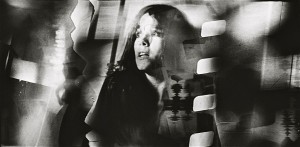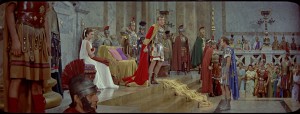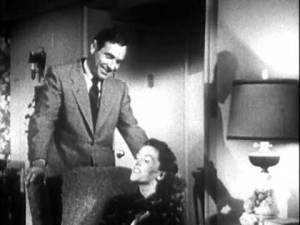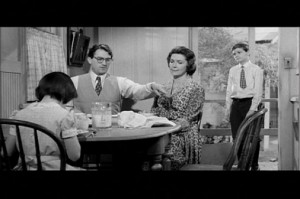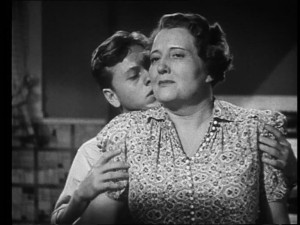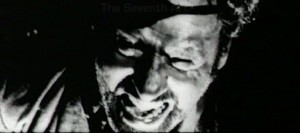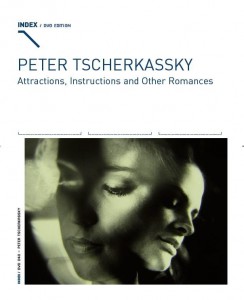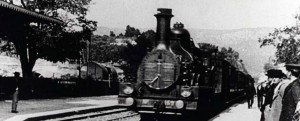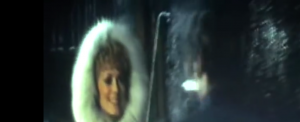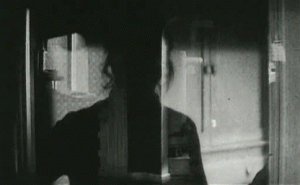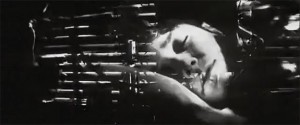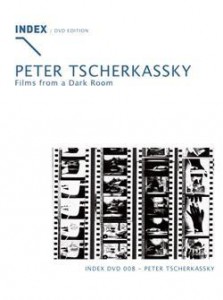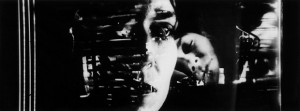Commissioned by Found Footage for its 4th issue (February 2018). — J.R.
We’re living through a confusing transitional period whose transitions are chiefly matters of financial speculation lying beyond our control. Theorizing our helpless condition — which often means attempting to rationalize it, or to adapt to it by other means — we’re obliged to use an out-of-date language. This antiquated language needs to be upgraded with a new vocabulary if we want to make useful sense of what’s happening — something that we haven’t yet figured out how to do. Just as “politically correct” language can sometimes be described as the language of defeat – struggling to make an adequate representation of a reality over which one has lost control – theoretical cinema suggests at times a farewell gesture towards a medium that has fled.
The fumblings to be found below are an attempt to clarify not so much five experimental films in 35-millimeter and CinemaScope by Peter Tscherkassky — L’Arrivée (1997-1999, 2:09 min.), Outer Space (1999, 9:58 min.), Get Ready (1999, 1:06 min.), Dream Work (2001,11 min.), and Instructions for a Light and Sound Machine (2005, 17 min.), all of which I find powerful, provocative, haunting, and ultimately confounding — as the confusing language used to describe them. I hasten to add that what makes this language confusing to me partially comes from the fact that I’ve never been a professional film academic, despite periodic employments in university film departments. My formative engagements with film, including 35-millimeter and CinemaScope, came as a moviegoer—more specifically, as the son and grandson of small-town film exhibitors in northwestern Alabama during the 1950s. My first encounter with CinemaScope, at age ten, came at an exhibitors’ convention in Atlanta in 1953, where 20th Century-Fox presented a test reel including clips from The Robe, How to Marry a Millionaire, and The Racers, as well as a rare item that may no longer exist today—a refilming of the “Diamonds Are a Girl’s Best Friend” number from Gentlemen Prefer Blondes in CinemaScope. For me, I should stress, 35-millimeter and CinemaScope were particularly attractive and all-encompassing versions of what I thought and felt the world was supposed to be like.
It’s in those terms that I can respond to the visceral and emotional jolts provided in the three found-footage films I’m most familiar with by Tscherkassky’s Viennese contemporary, Martin Arnold — pièce touché (1989), passage à l’acte (1993), and Alone. Life Wastes Andy Hardy (1996) -– perhaps because these disturbing shorts depend more noticeably on the affectivity of the material they’re working with and working on, teasing out the perverse subtexts in their (Hollywood) sources.
Tscherkassky does this in a somewhat more generalized fashion — arguably, L’Arrivée seeks to overwhelm the viewer as much as the Lumiére original did, and much the same could be said for his Viennale “trailer,” Get Ready – but without following as much of the same literal narrative contexts.
In a lucid and straightforward lecture in English given at the Jihlava International Documentary Film Festival in the Czech Republic in 2014 –an 82-minute “masterclass” devoted to how and why he made Instructions for a Light and Sound Machine – Tscherkassky repeatedly emphasizes that all his precise operations are predicated and dependent upon the “dinosaur” technology and analog material of 35-millimeter film as it’s exposed, processed, and projected. Nevertheless, the only way I could possibly see and hear his lecture was on YouTube, and the only way I could watch Instructions for a Light and Sound Machine for the purposes of this essay, including its annotated, step-by-step run-through in the lecture, was on the Index DVD collection of Tscherkassky shorts, Attractions, Instructions and Other Romances. I followed the lecture on my mobile phone and watched the film (that is, the “film”) on my DVD player. If I lived in Vienna, I’d likely have more opportunities to experience the effects of Tscherkassky’s material operations, but clearly most viewers have to depend like me on immaterial reproductions.
All of this suggests that a systematic misuse of language that keeps it imprecise, dictated by commerce and by convenience, automatically becomes part of any discussion of Peter Tscherkassky’s films. And not all of these imprecisions are necessarily or immediately obvious. His lecture was given at a documentary film festival, but is it correct to describe Instructions for a Light and Sound Machine as a documentary? If we decide to watch it or any other Tscherkassky film as if it were a fiction film, clearly our analysis would be different. And doesn’t the word “romances” imply fictions rather than documentaries? Furthermore, should we regard them as nonnarrative or as narrative films? The terminology employed above confusingly suggests both. Maybe we can and should watch them both ways, but this implies a descriptive vocabulary that we don’t yet have.
In the Q and A following his lecture, Tscherkassky explains that he tolerates digital reproductions of his work, unlike Peter Kubelka, because these reproductions would exist regardless of whether he tolerated them or not, and “good” digital reproductions, which he can authorize, are better than bad ones. This point is irrefutable, but even so, the fact that I’m presuming to discuss this work in digital form compels me to acknowledge that this paradox entails a systematic misuse of language, and one that characterizes a great deal of our shared contemporary life and discourse. It’s a distortion that can most often be traced back to a journalistic form of shorthand. In much the same way that it’s at least half a lie to call Barack Obama “black” and not “half-black” (or, for that matter, wrong to call any human being “black” whose skin color is brown or tan, or “white” anyone whose skin color is pink), or to describe the military occupation of Iraq as a “war”, or to define the “truth” (as Donald Trump and many of his acolytes routinely do) as an advertising slogan that generates income or votes, pretending to write here about Peter Tscherkassky’s work with found footage should clarify, first of all, that the footage in question that’s being discussed is more lost than found, especially when it comes to our own access to it. Maybe Tscherkassky found the footage, but somewhere in the course of its “delivery” to us, it gets lost.
Although it’s often argued or at least assumed that distinctions of this kind amount to pedantry, questions of language are central rather than peripheral to Tscherkassky’s work, which frequently, even somewhat systematically, employs metaphors that have a literary basis. The grounding of his filmmaking in film theory virtually guarantees this ongoing connection. From his own biography furnished on his web site (www.tscherkassky.at), one discovers that in 1978, before he turned 20, he first encountered avant-garde film at a five-day lecture series given by P. Adams Sitney at the Austrian Film Museum, and the following year he began studying philosophy (in both Berlin and Vienna) and acquired super-8 film equipment.
It’s also pertinent that over the past three decades, practically all of Tscherkassky’s films carry English titles (the only exceptions among eleven works are tabula rasa and L’Arrivée, the first of which functions as a recognizable term in English), although whether or not this is because English, like 35-millimeter and CinemaScope, is deemed to be part of the language of international commerce is a matter for speculation.
L’Arrivée clearly stands for August and Louis Lumiére’s L’arrivée d’un train en gare de La Ciotat (1896), the principal found footage used by Tscherkassky. (The other found footage used is a brief clip from Terrence Young’s 1968 Mayerling, set in the late 19th century, in which Catherine Deneuve steps off a train in Vienna and is greeted by Omar Sharif.) This is a famously emblematic film, but what makes the arriving train in it metaphorical is the way it is made to stand in for the cinema itself — as a powerfully “driven” industrial force, as a mode of “transportation,” and as a vehicle “carrying” a crowd of people (to cite only three possible metaphorical meanings, among many others). Like the doors and doorways in the metaphorically titled Outer Space (derived from Sidney J. Furie’s 1981 The Entity), or the windows in Dream Work and Instructions (taken, respectively, from The Entity and Sergio Leone’s 1966 The Good, The Bad, and The Ugly) or the graves in the latter, these metaphorical images ultimately seem to count more for what they signify than for what they are (or do, apart from signify).
Yet the above list barely begins to describe the proliferation of metaphors that appears on Tscherkassky’s own web site as five separate commentaries on L’Arrivée. The first of these is Tscherkassky’s own:
L’Arrivée is Tscherkassky’s second hommage to the Lumiére-brothers. First you see the arrival of the film itself, which shows the arrival of a train at a station. But that train collides with a second train, causing a violent crash, which leads us to an unexpected third arrival, the arrival of a beautiful woman – the happy-end.
Reduced to two minutes L’Arrivée gives a brief, but exact summary of what cinematography (after its arrival with Lumiéres’ train) has made into an enduring presence of our visual environment: violence, emotions. Or, as an anonymous American housewife (cited by T. W. Adorno) used to describe Hollywood’s version of life: “Getting into trouble and out of it again.”
After Tscherkassky proposes this metaphorical collision (in contrast to what we actually see and hear in the film, which is far more scrambled and confusing than a simple collision of two trains), the commentary by Christian Cargnelli vividly suggests that the “depicted train…literally shivers its way into the picture as if it had been incorrectly fed into the projector and was forced to do a dance in order to be seen properly.” And Stefan Grissemann’s metaphors similarly serve as explanatory stepping stones across the surface and duration of Tscherkassky’s film while also managing to mimic some of the filmmaker’s processes in his own style:
A white screen. Tabula rasa. Panavision. L’Arrivée shines on you like pure projected light, like the white surface still waiting for the marks of the film maker. In L’Arrivée, Peter Tscherkassky goes back to the beginning, back to lumière and the Lumières who, once upon a time, made a film of a train arriving.
And then the dirt begins to invade, the “story”, if you like. A frenzy in the soundtrack – it bangs, creaks, crackles and roars. From the right a grey veil approaches: the perforation of a strip of film. L’Arrivée makes cinema from mistakes, from derailments. Half pictures – the misty pictures of a grey delegation in station somewhere – penetrate the white surface. From right and left they run together, crash into each other and strive to separate themselves again. The material comes from Mayerling (1968), a Hapsburger melodrama from the British director Terence Young. The Eastman colour which was originally present has been exorcised by the film maker.
What Tscherkassky does here is drastically re-configure in CinemaScope. A train arrives and collides with its mirror image. Events begin to turn head over heels. Tscherkassky hystericalises the images. He allows them to lose their certainty, crosses soundtrack with perforation strip, changes positive to negative, slits the material open. Inside out and upside down. Phantom images – behind the veil of a film still running amok as if in the grip of a panicking collaborative cinematographic machine. A film star staggers into the final kiss – Catherine Deneuve alights, a man (Omar Sharif – which sounds like j’arrive) hurries towards her. A kiss. Bliss. An end. L’Arrivée is a film in the process of approaching. An orchestrated melodrama of dislocated viewing values made with sheer pleasure in disaster.
Finally, to conclude with the last of these English texts, Bert Rebhandl begins with a comparison to another early 20th century inventionbefore combining his own metaphors with an interpretation of whatMthey’re “saying”:
Just as the record player needle has to find the right groove, L’Arrivée has to settle into the perforation tracks before the narrative line can develop. A train arrives in a station where a hand-instigated collision with another train takes place. The event is not just a depiction, but a battle of the material itself. This is not the end, but the transition to a kiss, to the Happy End. L’Arrivée demonstrates where cinema begins – with the spectacular, and where it ends – with intimacy.
***
The first three of Tscherkassky’s CinemaScope films — L’Arrivée, Outer Space, and Dream Work — are found in the DVD collection entitled Films From a Dark Room, and the best account of what’s meant by “dark room” constitutes the final paragraph in Maureen Turim’s seminal “Works of Dreams and Shadows: The Films of Peter Tscherkassky,” published in a no less seminal collection of essays edited by Tscherkassky, Film Unframed: A History of Austrian Avant-Garde Cinema (Vienna: sixpackfilm, 2012). (Full disclosure: I am one of the many other contributors to this volume.)
What does it mean to make Films From a Dark Room, as Tscherkassky entitled his DVD anthology? His use of two words for “darkroom” clearly signals he is not simply indicating where he makes his films., It might ben useful to recall that the French phrase “chamber noire” means darkroom as well as what we call a “camera obscura” (from Latin), to indicate the photographic apparatus itself. He may, however, also want to connote films made subsequent to photography, through contact printing. However…even in their highly thought out structural ploys and art-historical intertextuality, these films are themselves a kind of Traumarbeit, emanating from that dark room we call the unconscious, and they are all the more powerful for that provenance.
Missing from Turim’s eloquent account is the dark room we call the film auditorium, the place where many of us traditionally watch (or watched) films in 35-millimeter and CinemaScope. Even if I watch Tscherkassky’s films on DVDs, and in rooms that are not as dark as the auditoriums of my childhood, these are still the dark rooms that for me stand in between Tscherkassky’s work and the discourse that typically surrounds them, rooms that I would like to be able to fill with my own form of discourse. But I don’t yet know how to reach this work from those rooms. Terms such as “unconscious” and “dream work” undoubtedly aim me in the right direction, but I need to know more, and what I need to know is more practical than theoretical. Specifically, I need to know whose unconscious and whose dream work are relevant here, and why they’re relevant. I hope in both cases it’s mine, because I wouldn’t know what to do with someone else’s.

